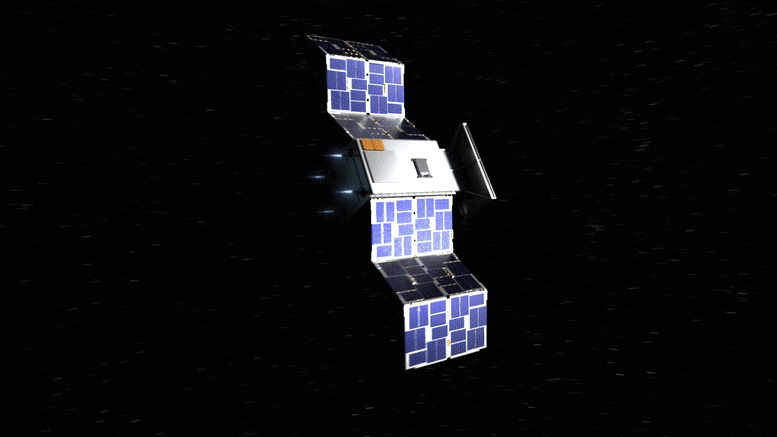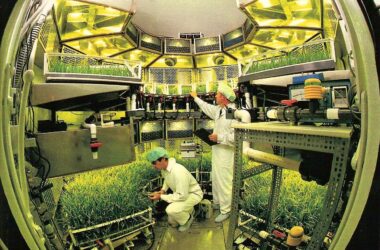
Le Cislunar Autonomous Positioning System Technology Operations and Navigation Experiment, ou CAPSTONE, est un CubeSat qui volera sur une orbite unique autour de la Lune, destinée au futur avant-poste lunaire Artemis de la NASA. Sa mission de six mois contribuera à lancer une nouvelle ère d’exploration de l’espace profond. Crédit : NASA Ames Research Center
Après un déploiement réussi et le début de la mise en service du vaisseau spatial le 4 juillet, le vaisseau spatial CAPSTONE (Cislunar Autonomous Positioning System Technology Operations and Navigation Experiment) a rencontré des problèmes de communication alors qu’il était en contact avec le Deep Space Network (DSN). L’équipe du vaisseau spatial s’efforce actuellement d’en comprendre la cause et de rétablir le contact. L’équipe dispose de bonnes données de trajectoire pour le vaisseau spatial, basées sur le premier passage complet et le second partiel de la station au sol avec le Deep Space Network. Si nécessaire, la mission dispose de suffisamment de carburant pour retarder de plusieurs jours la manœuvre initiale de correction de la trajectoire après la séparation.
Selon Advanced Space, qui pilote le vaisseau spatial pour le compte de ;” data-gt-translate-attributes=”[{” attribute=””>NASA, the operations team is actively working on this issue with the Deep Space Network and determining the best next steps:
- As a result of this anomaly, the first trajectory correction maneuver – originally scheduled for the morning of July 5th – has been delayed. This maneuver is designed to more accurately target the transfer orbit to the Moon. This maneuver is the first in a series that are designed to make small corrections to increase the accuracy of the transfer orbit to the Moon. The spacecraft remains on the overall intended ballistic lunar transfer (BLT) while this targeting maneuver is delayed.
- One of the benefits of the BLT, the designed trajectory, is its robustness to delays such as this.
- The mission transfer approach and system margins provide time to resolve and understand this anomaly before proceeding with the first trajectory correction maneuver.
- At the time of publication, the CAPSTONE spacecraft is currently approximately 285,000 km (175,000 miles) from Earth (~8 times GEO) on its planned ballistic transfer orbit to the Moon.
CAPSTONE volera sur une orbite unique, en forme de halo, autour de la Lune avant que cette orbite ne soit utilisée par Gateway, le futur avant-poste lunaire de la NASA pour notre programme Artemis. La mission CAPSTONE, abréviation de Cislunar Autonomous Positioning System Technology Operations and Navigation Experiment, validera les technologies de navigation et la dynamique orbitale pour Gateway, qui servira un jour de zone d’étape pour les missions vers la Lune et potentiellement de point de saut pour les missions vers Mars.
Following CAPSTONE’s initial deployment on July 4, the spacecraft was able to successfully deploy solar arrays, stabilize, and began charging its onboard battery. CAPSTONE’s propulsion system was also readied for the spacecraft’s first maneuver. CAPSTONE made initial contact with the DSN ground station in Madrid, Spain, followed by a partial contact with the Goldstone ground station in California. From these contacts, mission operators have been able to determine CAPSTONE’s approximate position and velocity in space.
According to Advanced Space, the spacecraft was commissioning nominally for the first 11 hours:
- Spacecraft was deployed successfully from the launch vehicle.
- Spacecraft successfully deployed solar arrays, achieved three-axis stabilization, and entered a battery charging mode.
- Spacecraft successfully executed Earth-pointing mode, communicated with DSN stations in Madrid Spain and the operations team began check-out and commissioning of the spacecraft.
- The operations team was able to determine spacecraft state (position and velocity) and design initial trajectory correction maneuver.
- Propulsion system was commissioned and prepared for the first trajectory correction maneuver.
As a result of the communications issues, CAPSTONE’s first trajectory correction maneuver – originally scheduled for the morning of July 5 – has been delayed. This maneuver is the first in a series that are designed to make small corrections to increase the accuracy of the transfer orbit to the Moon, and the spacecraft remains on the overall intended ballistic lunar transfer while awaiting this trajectory correction.
Teams are working to resolve CAPSTONE’s communications issues.


